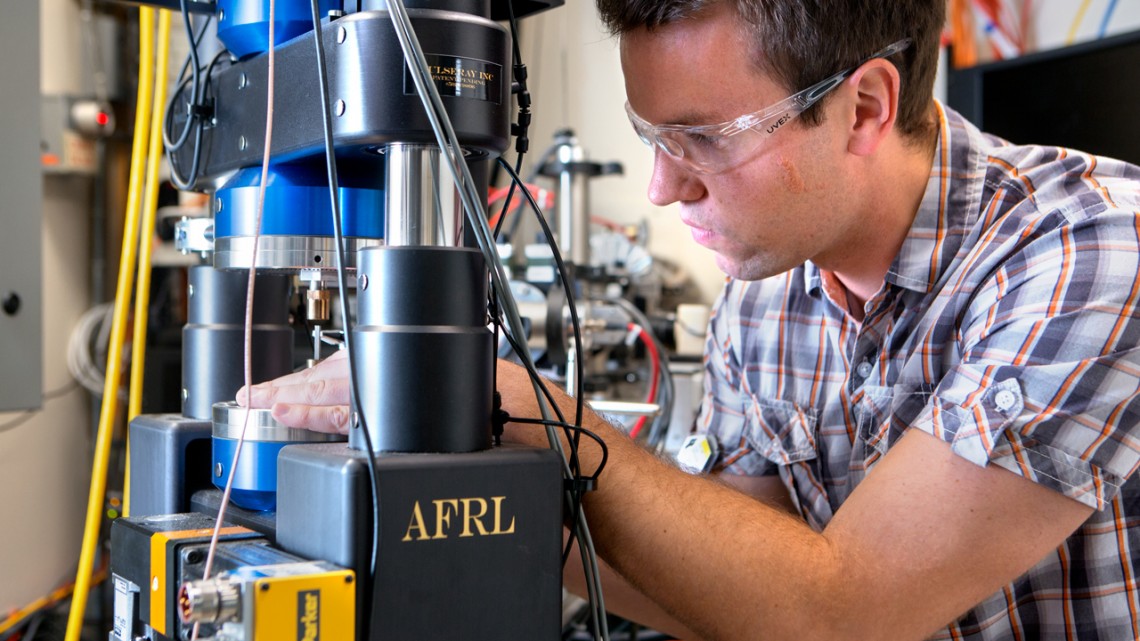
Graduate student Mark Obstalecki prepares a sample for the Rotational and Axial Motion System at the Cornell High Energy Synchrotron Source.
CHESS receives Air Force funding for materials subfacility
By Rick Ryan
The Cornell High Energy Synchrotron Source (CHESS) will create a new materials research subfacility, thanks to $7.1 million in funding from the Air Force Research Lab (AFRL).
The new Materials Solutions Network at CHESS (MSN-C) will provide dedicated access to two new X-ray beamlines at CHESS for Air Force and other Department of Defense materials researchers, and original equipment manufacturers. High-intensity, high-energy X-ray beams available at the newly upgraded CHESS facility will enable breakthroughs in materials and designs for military components.
Through this research, MSN-C aims to improve the performance and safety of new and existing materials, while lowering cost.
“This well-deserved federal investment in Cornell’s CHESS lab will ensure America and Cornell University remain at the cutting edge of innovation in high-energy X-ray applications,” said Senate Minority Leader Charles Schumer, D-N.Y. “CHESS at Cornell is a unique facility that keeps the U.S. competitive when it comes to the development of advanced materials, and is part of the lifeblood of our scientific community, enabling researchers to make advancements in everything from clean-energy technologies to stronger and more resilient infrastructure.”
“I have been proud to fight for and deliver federal resources for CHESS to advance its groundbreaking research,” he said, “and will continue fighting tirelessly to do so.”
MSN-C is the latest subfacility in the newly formed partner-funded model at CHESS, joining CHEXS and MacCHESS.
The new subfacility will consist of two dedicated X-ray beamlines – the structural materials beamline and the functional materials beamline.
With the structural materials beamline, researchers will use high energy X-rays to understand the evolving internal structure of metals, polymers, ceramics and composites during service and processing conditions. The beamline will allow researchers to observe materials in real time and at length scales from atomic bonds to that of structural components such as turbine blades or weld joints.
Traditional design testing considers material behavior at the macro or component scale, rather than at the atomic scale. Using emerging X-ray techniques developed at CHESS and around the world, it is now possible to measure and simulate how each individual atomic crystal in a sample evolves over time – for example, during stress experienced by a titanium compressor blade in a jet engine. Eventually, a fatigue crack will begin at the atomic scale.
In addition to helping predict when this crack will occur, researchers can use X-rays to watch and understand the crack’s evolution and growth.
“There are still age-old design challenges that we haven’t yet conquered. The structural materials beamline at MSN-C was created to attack those challenges directly,” said Matt Miller, professor of mechanical and aerospace engineering, associate director of CHESS and principal investigator for MSN-C. “With the promise of 3D printing and the creation of brand-new functional materials, there are going to be new challenges as well.”
The functional materials beamline is designed for analysis of soft materials, such as organic molecule and polymer-based materials and composites used in light-weight structural components and organic electronics, among other applications.
This beamline will permit studies of materials used in 3D printing and other additive manufacturing techniques. Such studies will help Air Force researchers and others understand the complex links between process conditions, structure and function.
The X-ray data from MSN-C will play a fundamental role in designing military aircraft components from the single crystal scale upward, and producing components using 3D printing.
Arthur Woll, director of MSN-C, said the new subfacility builds on and redefines what makes CHESS unique.
“The trend for synchrotrons, including CHESS, has been to emphasize novel X-ray technique development over application of those techniques to solve real-world problems, especially those faced by engineers or manufacturers,” he said. “A central goal of MSN-C is to modify this trend by altering the rules governing access to beamtime, such that researchers can apply state-of-the art X-ray techniques to solving critical, real-world manufacturing problems.”
While CHESS is the first node of the materials solutions network to provide dedicated research for AFRL, Miller said the future could include more facilities like CHESS.
“The vision for the network,” he said, “is to organize all user facilities within the U.S. that characterize materials, creating a consortium where industry can go to solve some of their toughest problems. There is a great need for this type of research in the U.S. to keep us competitive at the global scale. We’ll begin that network here at CHESS.”
Rick Ryan is a science communicator for the Cornell Laboratory for Accelerator-Based Science and Education.
Media Contact
Get Cornell news delivered right to your inbox.
Subscribe
